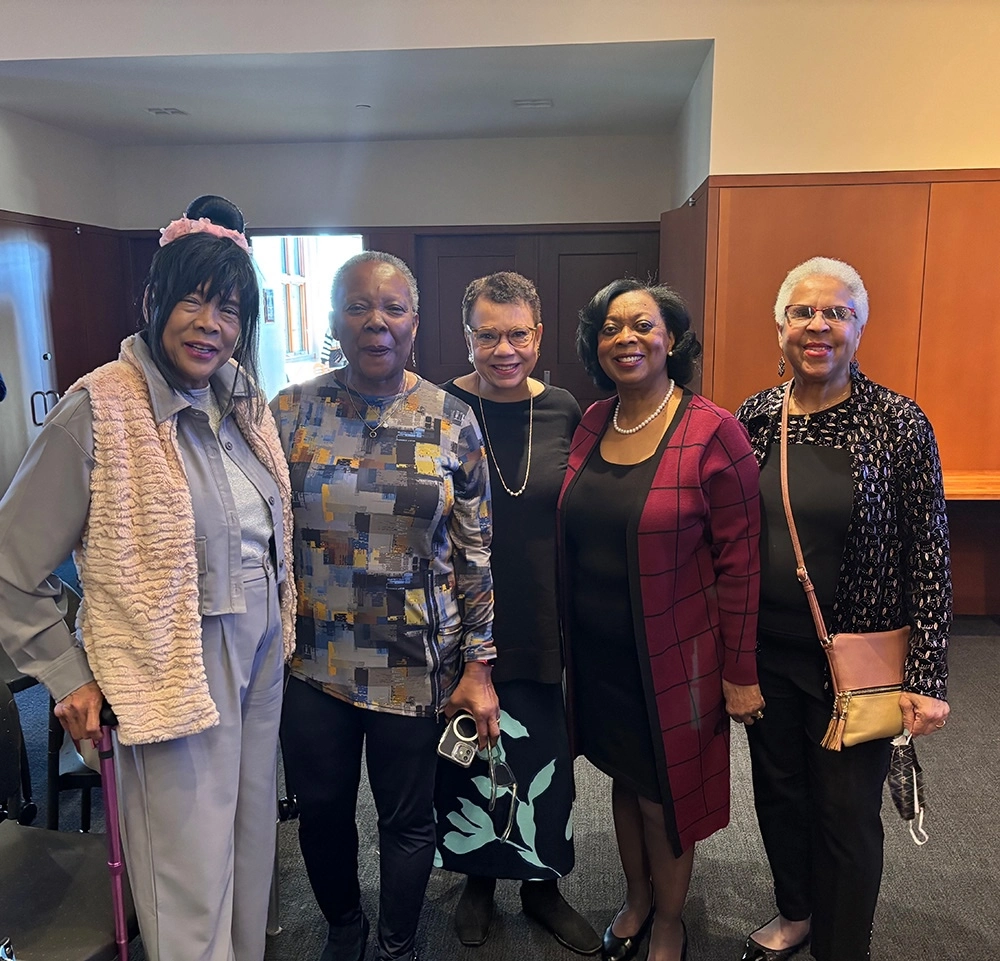Association of Beaver College Blacks Shares Stories of Time on Campus; Honored With Public Art Display

Students, alumni, faculty, and friends of the University packed the Beaver College Reading Room in Landman Library on March 27 for “Justice From Then to Now,” a symposium featuring several founding and early members of the Association of Beaver College Blacks (ABCB), a student group that advocated for a more equitable Beaver College.
Laughter filled the air at times and tears flowed at others as Ruth Baronda ’72, Dr. Priscilla Hambrick-Dixon ’71, Vernell Beamon-Grant ’71, Thelma Harris ’71, Nora Johnson-Price ’71, and Dr. Blanche Staton ’73 spoke about their time on campus, what they accomplished decades ago, and how their advocacy can be an inspiration for activism in today’s tumultuous times.
”We were very strategic,” Beamon-Grant explained. “We used to have planning meetings, and we talked about what we would say, who would say it. It couldn’t be just random like we’re talking now, but to decide who was gonna represent us. That was very educational, and it’s very empowering.”
ABCB advocated for more representation of the African Diaspora on campus by demanding more books, classes, events, and professors and mentors who reflected that background.
“ We decided that we weren’t going to wait for something to happen; we were gonna make it happen,” Beamon-Grant said.
“When we got here, there was no Black staff on the education side. The only Black people here were the kitchen staff and the custodial staff. It was quite striking to come here and not have any Black professors, so it quickly became one of our goals to get more Black educators at Beaver.”
While they worked with each other on many serious matters, there was still time for fun.
“ We would have our dances in the dining hall,” Baronda told the audience. “We moved the chairs to get ready, and we would have everyone dancing as often as we could. So no problem having fun in the dining hall.”
”For me, one social aspect that comes to mind is when Mr. Woodland (a Black professor at Beaver College) passed on, we had a memorial program and we discovered that we could sing,” Hambrick-Dixon added. “We put a group together called the Onyx that traveled to places like New York to sing together.”
Many of the ABCB members stay in touch to this day.
“ It’s a basic, fundamental human need to feel valued, to feel included, to feel supported, and to have a sense of community,” Staton said. “So for me, the Beaver College Blacks was where I felt I belonged. From then until now, they have made a difference in my life. My dearest friends are from Beaver College. We’ve been together for a very long time. We have helped each other through tough times. We lift each other up, we encourage each other, and we show up for one another. “
ABCB’s legacy can be seen on Arcadia’s campus today with the Black Awareness Society, a student group that changed its name from the Association of Beaver College Blacks to the Black Excellence Society in 1984, as well as other student groups that utilized ABCB’s work and advocacy as a blueprint.
“In retrospect, it’s like ‘we did that?’ We really made a difference, and not just for us, but for all of us,” Beamon-Grant exclaimed.
After the panel discussion, the crowd moved to the first-floor courtyard for the unveiling of two benches with a planter centerpiece, an Arcadia Public Art Project honoring ABCB’s legacy.
Current students and several recent alumni, including Ellie Breault ’25, Grace Clark ’24, Charlie Deppen ’26, Xavier Dube ’24, Emily Fisher ’25, Kelsey Logue-Struble ’26, Callie McGuire ’26, Gertie Smith ’27, Justin Steerman ’25, and Njambi Womack ’24, worked alongside NE Brown, the University’s 2024 Artist in Residence. Student-made mosaic tiles, some of which contain newspaper articles written by ABCB members, make up the planter, while the benches will have QR codes that can be scanned to listen to the oral histories of ABCB members collected by students in the public art class taught by Krista Profitt ’11
“I come from a town right in the center of Pennsylvania that has a population smaller than the number of people who attend Arcadia,” Deppen said. “ So building community at Arcadia has always been so important and special to me. Getting to learn about people who built a community from the ground up, basically, is so amazing.”

The Arcadia Public Art Project creates community-focused public art projects rooted in Glenside, Pa. Student apprentices work with professional artists and Arcadia faculty to design and fabricate a growing collection of public artwork. The project aims to build bridges between the diverse communities that call Glenside home, in the service of contributing to a more connected, sustainable, and equitable community.


